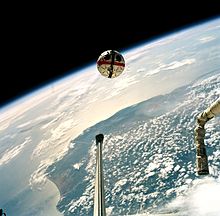MECHATRONICS IN SPACECRAFT MANUFACTURING
History
The first space mission, Sputnik 1, was an artificial satellite put into Earth orbit by the USSR on 4 October 1957. On 3 November 1957, the USSR orbited Sputnik 2, the first to carry a living animal into space – a dog.[1]
Ten other countries have successfully launched orbital missions using their own vehicles: USA (1958), France (1965), Australia (1967),Japan and China (1970), the United Kingdom (1971), India (1980), Israel (1988), Iran (2009), and North Korea (2012).[2]
Design
JPL divides the "flight system" of a spacecraft into subsystems.[4] These include:In spacecraft design, the United States Air Force considers a vehicle to consist of the mission payload and the bus (or platform). The bus provides physical structure, thermal control, electrical power, attitude control and telemetry, tracking and commanding.[3]
Structure
This is the physical backbone structure. It:
- provides overall mechanical integrity of the spacecraft
- ensures spacecraft components are supported and can withstand launch loads
Data handling
- command sequence storage
- maintaining the spacecraft clock
- collecting and reporting spacecraft telemetry data (e.g. spacecraft health)
- collecting and reporting mission data (e.g. photographic images)
Attitude determination and control
This system is mainly responsible for the correct spacecraft's orientation in space (attitude) despite external disturbance-gravity gradient effects, magnetic-field torques, solar radiation and aerodynamic drag; in addition it may be required to reposition movable parts, such as antennas and solar arrays.[5]
Telecommunications
Components in the telecommunications subsystem include radio antennas, transmitters and receivers. These may be used to communicate with ground stations on Earth, or with other spacecraft.[6]
Electrical power
The supply of electric power on spacecraf t generally come from photovoltaic (solar) cells or from a radioisotope thermoelectric generator. Other components of the subsystem include batteries for storing power and distribution circuitry that connects components to the power sources.[7]
t generally come from photovoltaic (solar) cells or from a radioisotope thermoelectric generator. Other components of the subsystem include batteries for storing power and distribution circuitry that connects components to the power sources.[7]
Temperature control and protection from the environment
Main article: Spacecraft thermal control
Propulsion
Main article: Spacecraft propulsion
Mechanical devices
Mechanical components often need to be moved for deployment after launch or prior to landing. In addition to the use of motors, many one-time movements are controlled bypyrotechnic devices.[9]
Control
Robotic spacecraft use telemetry to radio back to Earth acquired data and vehicle status information. Although generally referred to as "remotely controlled" or "telerobotic", the earliest orbital spacecraft – such as Sputnik 1 and Explorer 1 – did not receive control signals from Earth. Soon after these first spacecraft, command systems were developed to allow remote control from the ground. Increased autonomy is important for distant probes where the light travel time prevents rapid decision and control from Earth. Newer probes such as Cassini–Huygens and the Mars Exploration Rovers are highly autonomous and use on-board computers to operate independently for extended periods of time.[10][11]
Space probes
Robotic spacecraft service vehicles
- MDA Space Infrastructure Servicing vehicle — an in-space refueling depot and service spacecraft for communication satellites in geosynchronous orbit. Launch planned for 2015.[12]
- Mission Extension Vehicle is an alternative approach that does not utilize in-space RCS fuel transfer. Rather, it would connect to the target satellite in the same way as MDA SIS, and then use "its own thrusters to supply attitude control for the target."[13]




No comments:
Post a Comment